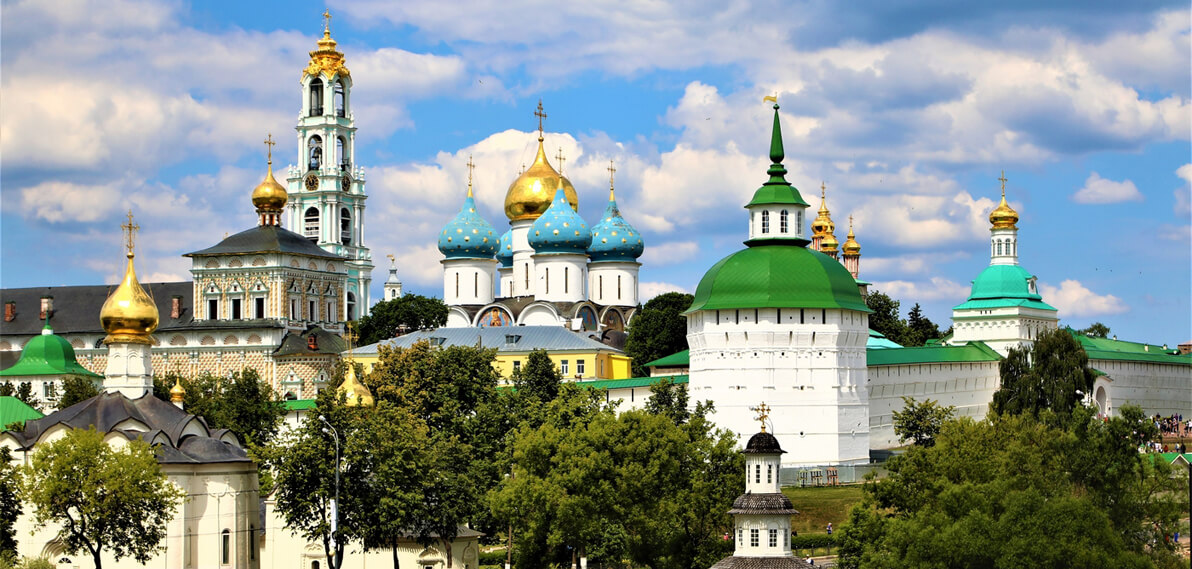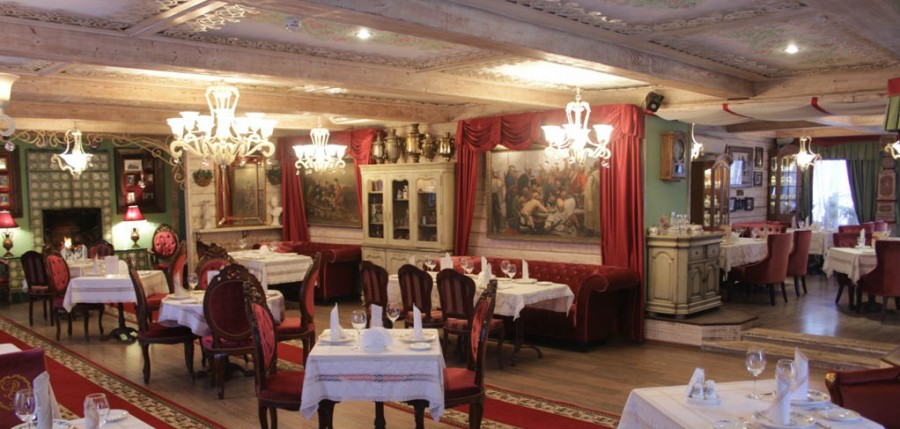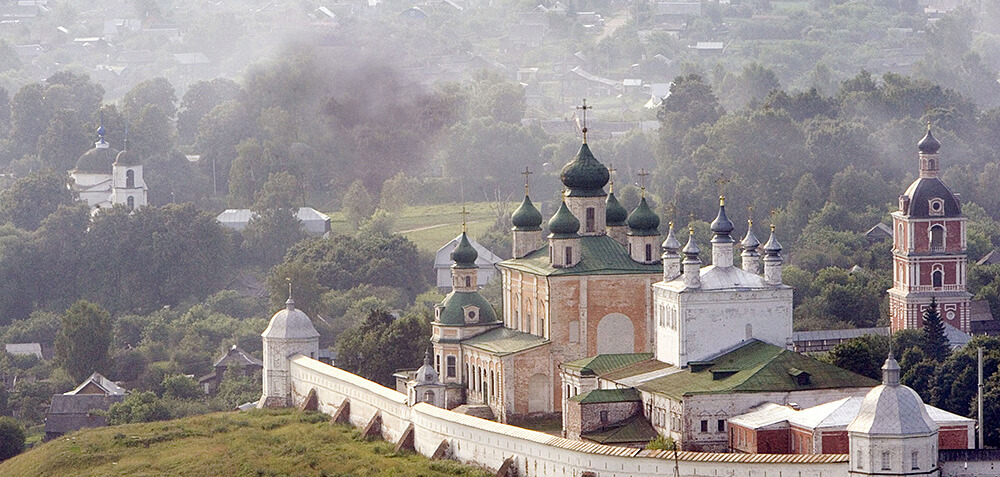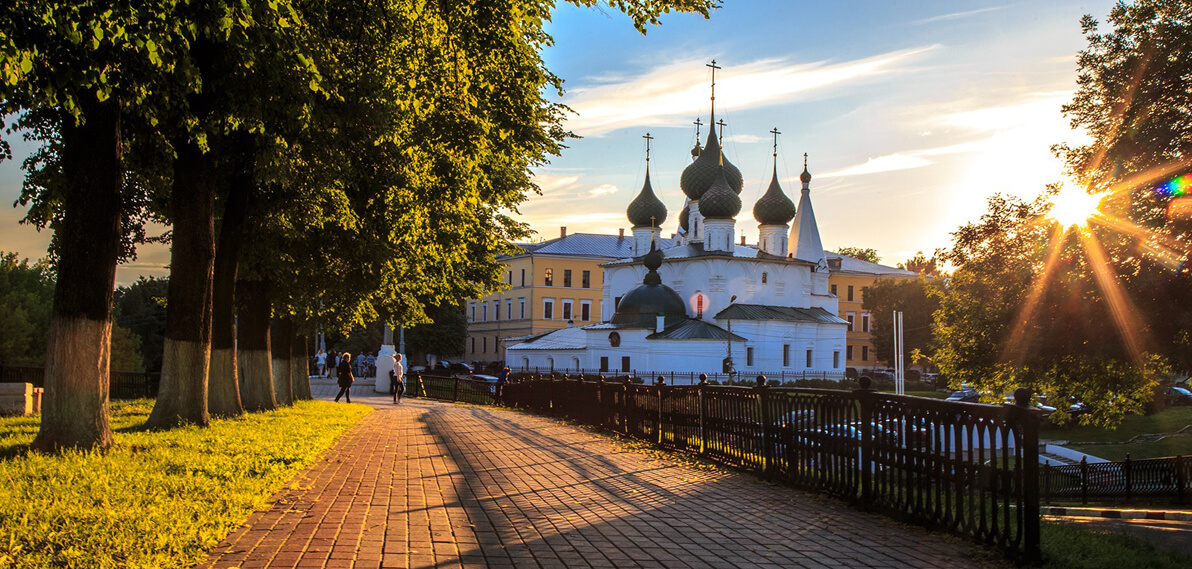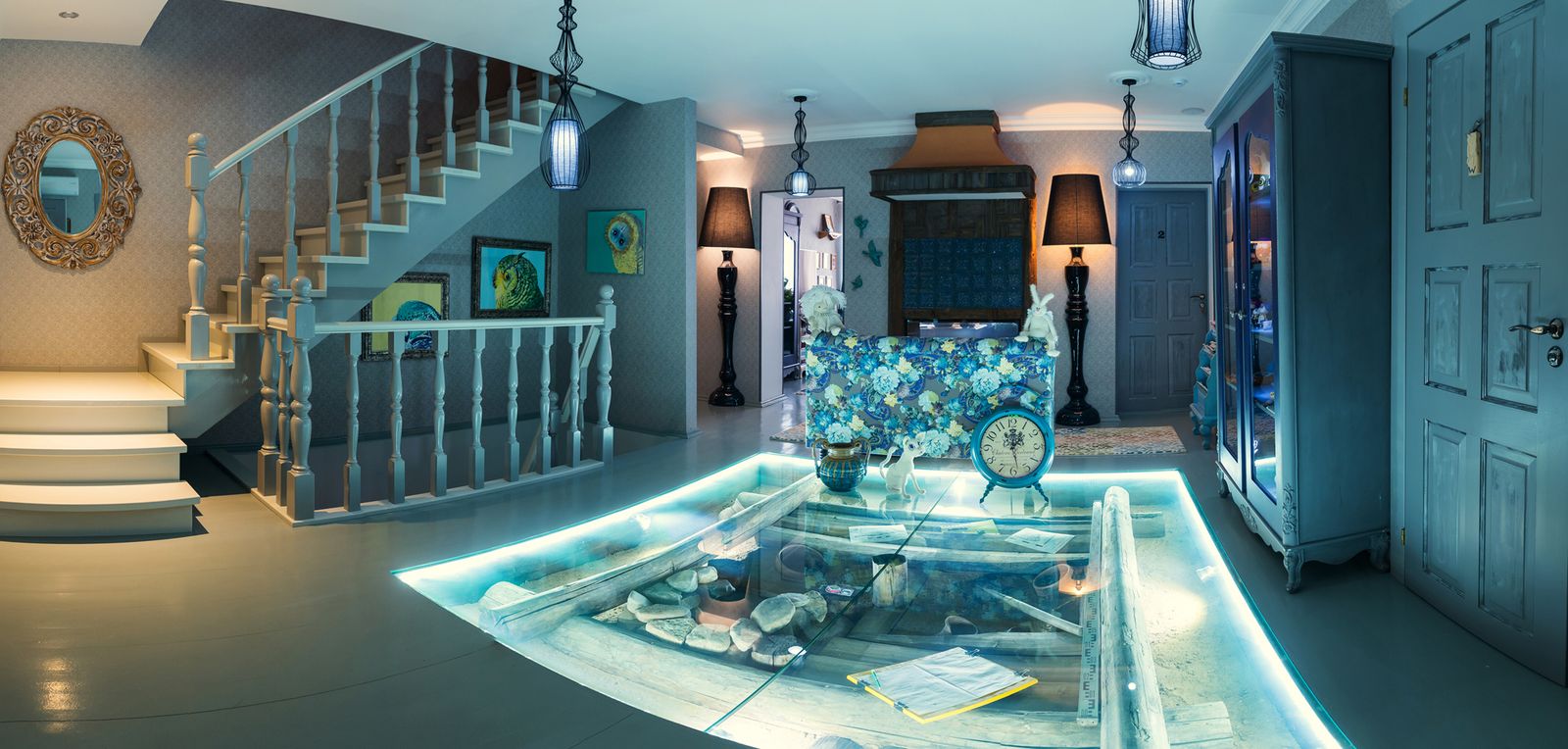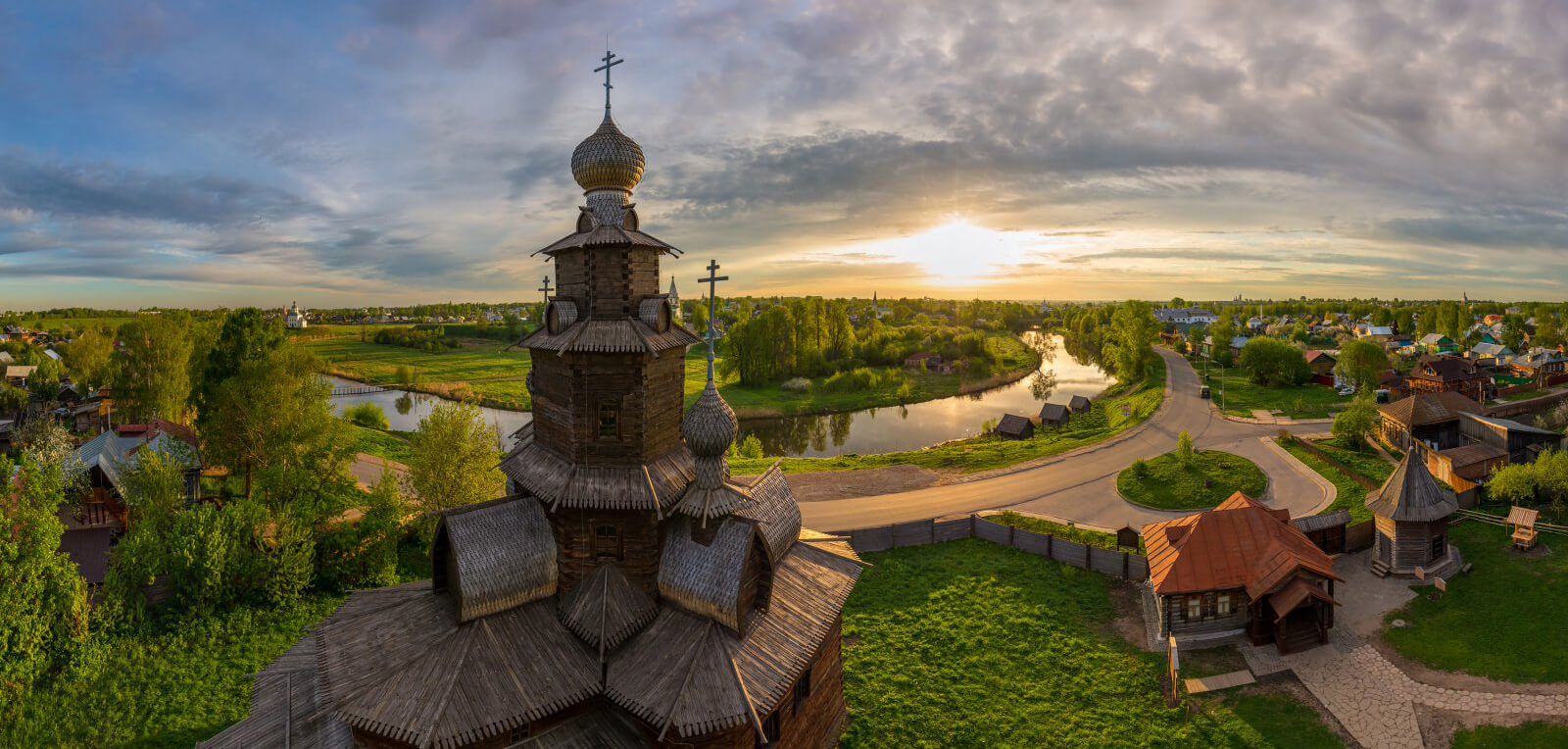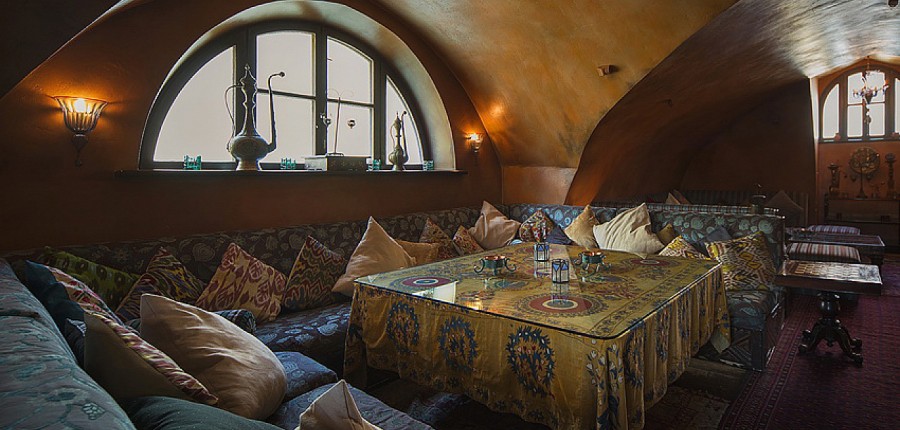The Moscow-Ples way
Needless to say, the way from Moscow to Ples is somewhat long. While on the road, you may feel the need for new impressions and delicious cuisine.
The road to Ples lies through many old cities of the Golden Ring. Surprisingly, by increasing your journey by 3-4 hours, you can get to see so much!
We recommend leaving Moscow via Yaroslavskoye highway early in the morning: this will help you avoid traffic jams.
Distance: 70 km., 1-1.5 hours from Moscow.
The origin of the name Sergiev Posad: Posad is a "trades and crafts settlement" or, in modern terminology, an "urban type settlement", that is a small town. The city was founded by saint Sergius of Radonezh.
Main attractions: The historical core of the city is the famous Trinity Monastery, founded in the 1340s by St. Sergius of Radonezh and later named the the Trinity Lavra of St. Sergius. Since 1993, the architectural ensemble of the Trinity Lavra of St. Sergius has been included in the UNESCO World Heritage List.
The Trinity Lavra of St. Sergius. Trivia.
- In 1380, on the way to Kulikovo Field battle, prince Dmitry Donskoy and his army stopped at the monastery. Sergius of Radonezh spent a long time in conversation with him, predicting his victory over khan Mamai. He also sent two warrior monks to help Dmitry - Oslyaba and Peresvet.
- Sergius of Radonezh died in 1392 at the age of 72. His body was buried in the main church of the Lavra – the Trinity. 30 years after his death, the monks opened the coffin and found that their elder's body was incorrupt.
- For the iconostasis of the Trinity Cathedral, the iconographer Andrei Rublev painted his famous "Trinity". He also, together with another outstanding iconographer of those times, Daniel Сhyorny, painted the walls of the cathedral.
- There was a centuries-old tradition of the royal family donating special gifts to the monastery in honor of Orthodox holidays, victories and the birth of heirs. Thus the accumulated valuables were collected over time in a special sacristy, which became something like a museum.
- In 1685 The Moscow Theological Academy, the first higher educational institution in Russia, was founded in the Lavra. Among the graduates of this academy are Lomonosov, Klyuchevsky, and Magnitsky. The seminary is still in operation, its students receive a full humanities education.
- The Trinity Lavra of St. Sergius more than once sheltered royals behind its walls. And so, tsarina Sophia (during the Streltsy riot), and Natalia Kirillovna, the mother of future tsars Peter and Ivan, and the young Peter I himself fleeing from his sister's conspiracy, found salvation here.
- Inside the monastery walls there is a wine cellar, known since the time of the Polish attack. There is even a special position of cupbearer among the monks. Now wines aged since 1946 are stored in its cellar.
- The Lavra is famous for its ancient church bells still in use: "The Swan" (1593) and "Nikonovsky" (1420).
- Now the brotherhood of the Lavra has about 200 monks. The monastery also has an Orthodox publishing house (the Patriarchal Publishing and Printing Center of the Holy Trinity-Sergius Lavra) and a pilgrimage center.
Restaurants
And as for the daily bread, we recommend those who are hungry and have not had breakfast to visit the Russian Courtyard restaurant. We ourselves, on our way from Moscow, often come to the restaurant and are always satisfied with the level of service and its food quality. The cuisine is the definitely Russian: blini, borscht, pelmeni.
Address: Sergiev Posad, Krasnoy Armii Avenue, 134/2
Phone numbers:
8(496)540-51-14
8(496)547-38-52
8(495)786-87-88
Finally: the Gremyachy spring, or "the roaring one".
Close by Sergiev Posad in the village of Vzglyadnevo there is a locally famous Gremyachy spring. The spring gushes from the middle of a steep hill through a crevice in the limestone and rolls down in waterfall 25 meters high. The water has a temperature of 6 degrees Celsius year round and has beneficial properties. You can safely drink it, or you can take a bath in the equipped bathhouse.
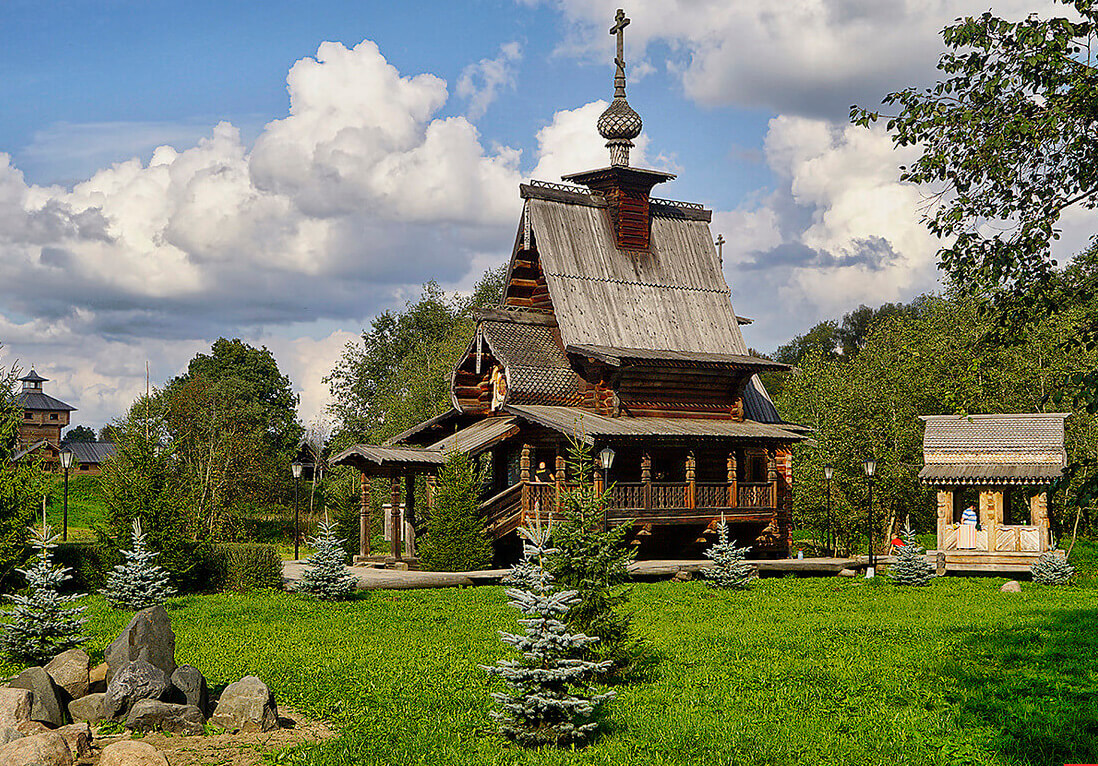
The way to Gremyachy spring is not so easy! In rainy weather you should refrain from travelling there. But by deciding to make this trip you will add another interesting place on the map of Russia to the bank of your impressions.
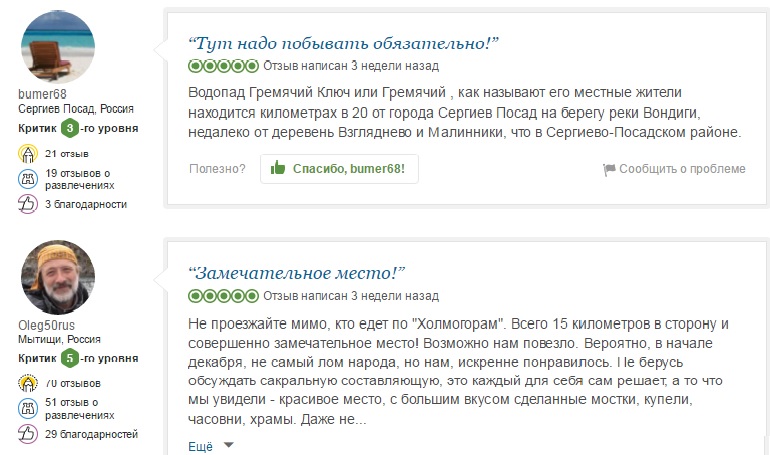 How to get there: from Sergiev Posad we leave towards Yaroslavl. After the village of Naugolnoye, turn right onto the A108 ring road to the "Moskovskoye Bolshoe Koltso" or the "Moscow Big Ring", and drive along the ring road for 17 km. After the bridge on the Vondiga River, turn right to the sign "Botovo village", "Gremyachy Klyuch spring". We are going 1.5 km on an asphalt road, then turn onto a dirt road to the right.
Another 3 km and you are at the goal!
How to get there: from Sergiev Posad we leave towards Yaroslavl. After the village of Naugolnoye, turn right onto the A108 ring road to the "Moskovskoye Bolshoe Koltso" or the "Moscow Big Ring", and drive along the ring road for 17 km. After the bridge on the Vondiga River, turn right to the sign "Botovo village", "Gremyachy Klyuch spring". We are going 1.5 km on an asphalt road, then turn onto a dirt road to the right.
Another 3 km and you are at the goal!
Distance: 66 km from Sergiev Posad, 40 minutes on the way.
The origin of the name Pereslavl-Zalessky: named after the southern Russian city of Pereyaslavl. Since the XV century the pronunciation has changed to Pereslavl-Zalessky, since it was located behind the forests of Zalessye — the area of fields and agriculture.
Main sights: Spaso-Preobrazhensky Cathedral, Goritsky Assumption Monastery, the Kharitonov Arboretum Garden, Peter the First's Boat Manor Museum, the Alexander Nevsky Museum, the Clothes Iron Museum.
Pereslavl-Zalessky. Trivia.
- The city was founded in 1152 by prince Yuri Dolgoruky.
- It was here that the young Peter I laid the foundation of the Russian fleet, creating his "fun flotilla".
- Pereslavl-Zalessky is the birthplace of Alexander Nevsky. The grand prince was born here in 1220.
- Pereslavl (1152) is only five years younger than Moscow (1147).
- Peter the First's Boat Estate Museum is the first provincial museum in Russia (3.5 km from the city, Vaskovo village, tel.: (48535) 2-31-24, 6-21-16,
3-81-00) - The Pereslavl Fyodorovsky Monastery in the late XVII – early XVIII centuries was a kind of female political prison. Her prisoners were supporters of princess Sophia, the wife of the Prosecutor General of the Senate P.I.Yaguzhinsky, and other high-born persons.
- The earthen ramparts, built in the XII century, still remain one of the most impressive defensive structures in the central part of Russia that have survived to the present day. Their circumference is 2.5 km and their height is about 10 m.
- The life and work of the famous Russian writer M.M. Prishvin are closely connected with the Pereslavl region. Fascinated by the beauty of the Zalesye nature, Prishvin received a lot of impressions here and wrote many stories based on them, including one of his most famous works "The Storeroom of the Sun", now included in the state school curriculum.
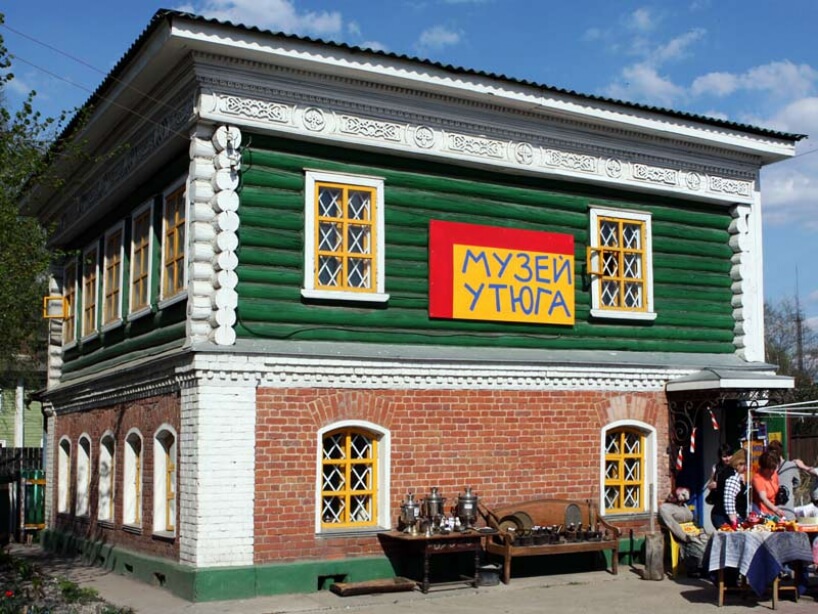
Restaurants.
If hunger overtakes you in Pereslavl-Zalessky, visit Green Sova — the younger sister of Grand Sova, to taste our specialty dishes.

Address: Yaroslavl region, Pereslavl-Zalessky, Moskovsky lane, 16.
Phone number: +7 (902) 223-38-00
Finally: Lake Pleshcheyevo.
The lake was formed 30 thousand years ago. People come here to admire its unique natural landscapes and ancient temples. Archaeologists have also found more than two thousand Meryan mounds and primitive men sites around it.
Lake Pleshcheyevo is known as the cradle of Russian fleet: Peter the First laid down a shipyard near the village of Veskovo, where ships to sail on the lake were to be built. Now there is a museum-estate "Peter the Great's Boat". Yarila's Hill rises nearby: a hill on top of which pagan rituals were performed in honor of god Yarila.
The entire lake and the town are included in the Pleshcheyevo Lake National Park, which was created in 1998 to preserve these unique lands.
At the exit from the city, the first left turn onto Priozerskoye. After 500m you will encounter the Nikitskaya Sloboda. The temple remains on the left, yet we go further (straight). Another 3,700 m, and (on the left) you will see the sign "Siny Kamen". From the sign we go to the left 150 meters. In total, from the turn to Priozerskoe to the stone goes out — 4,200 meters, Kriushkino village, the foot of Yarila's Hill.
Distance: 61 km from Pereslavl-Zalessky, 60 minutes.
The origin of Rostov's placename: it owes its origin to the Old Slavic name Rost (the name Rostislav also came from it). The affix Veliky, "the great", not only distinguishes it from the Rostov-on-Don namesake, but also emphasizes the importance of this small town in Russian history. To avoid confusion about who lives where, residents of the city of the same name on the Don are called "Rostovchane", and of Rostov the Great – "Rostovtsy".
Main attractions: Assumption Cathedral, Belfry of the Assumption Cathedral, Horse Gallery, the Finift Museum*, Lake Nero. The historical part of Rostov Veliky is concentrated on the western shore of Lake Nero. In the centre stands the main attraction — the Rostov Kremlin.
The Finift is a type of applied arts that uses vitreous powder, called enamel, on a metal substrate. The glassy coating is durable and does not fade over time. Address: Yaroslavl region, Rostov, Borisoglebskoe highway, 3. Phone number: +7(48536) 7-49-21; +7(915)988-99-16
The Rostov Kremlin. Trivia.
- The entire territory of the Kremlin is surrounded by powerful stone walls, which perform a decorative rather than a defensive role, because the Kremlin itself was originally planned not as a defensive structure, but as the residence of the metropolitan bishop. Owing to this the Rostov Kremlin differs from all others in its special elegance and sophistication.
- The Kremlin was planned by the metropolitan of the Rostov diocese, Jonah Sysoevich. In 1670 he conceived of building his residence on the model of the "City of God, fenced off from the mundane world." Monasticism was considered an "angelic rank", and therefore the metropolitan wanted to live "almost" in the Garden of Eden.
- In the 70s, the Rostov Kremlin hosted the filming of the beloved Soviet comedy film "Ivan Vasilyevich changes his profession." The movie heroes were in pursuit along the long passages, which connect all the buildings of the Kremlin.
Restaurants:
We recommend eating at the Shchuchy Dvor Academy. The fish-based cuisine is great. You definitely need to try fish in Rostov, because the famous Lake Nero is nearby! The fish from the local purest reservoirs is famous far beyond Rostov Veliky.
Address: Rostov Veliky, Dostoevsky str., 41
Phone number: +7 (910)973-43-64.
Finally: Lake Nero.
People began to live here about 6,000 years ago, and the reservoir is already 500,000 years old. Rostov Veliky became the official owner of this "freshwater sea" only in 1917. Before that, it was owned by various landowners, the State Treasury, and then by peasants from the coastal villages of Porechye-Rybnoye and Ugodichi. There are legends that Rostov's Lake keeps treasures at its bottom, left by local residents during the Mongol invasion.
There are many stories associated with Lake Nero. Peter I, after listening to the enthusiastic stories of his confidants, dreamed of building the prototype Russian fleet here. But having seen the lake with his own eyes he was disappointed: in its deepest place, the water column did not exceed the height of Peter himself. And the rest was occupied by a thick layer of silt. Calling Nero 'a dirty puddle', the sovereign hurried away from Rostov and Lake Pleshcheyevo became the cradle of the Russian fleet instead.

How to get there: they don't like road pointers in Rostov!
The Spaso-Yakovlevsky Monastery stands on the lake shore. Local residents will help you get to the lake.
Distance: 56 km from Rostov, or a little less than an hour on the way.
The origin of the city's name: based on the ancient possessive form of the name Yaroslav, legends based on local legends, and a number of other considerations, Yaroslavl was founded by Yaroslav the Wise during his Rostov principality (988-1010).
Main sights: the Transfiguration Monastery, the Assumption Cathedral, the Church of Elijah the Prophet, the Church of John the Baptist, the Holy Presentation Convent, the Millennium Park, the Historical and Architectural Museum Reserve, and the Einstein's Entertaining Museum of Sciences.
Yaroslavl. Trivia.
- The oldest building in Yaroslavl: the Transiguration Monastery. Before the Revolution it housed a repository of ancient manuscripts and books. It happened once that the only copy of the "The Tale of Igor's Campaign" to be preserved was discovered here.
- Yaroslavl is the first Christian city on the Volga river.
- Legends tell us that there was a village "Bear Corner" on the site where the historical centre of the city is now located. The Merya tribes worshipping pagan gods lived here.
- During the Time of Troubles, Yaroslavl briefly became the capital of the Russia. An all–Russian government, the Council of All the Lands, was located here for some time.
- Yaroslavl is the birthplace of Russian theater. In 1750, the first Russian national public theatre was created here by Fyodor Volkov.
- Yaroslavl was one of the first cities in Russia to have a Freemasonry lodge.
- The world fame was brought to Yaroslavl by the first space of our countrywoman, the first female cosmonaut Valentina Vladimirovna Tereshkova, on June 16, 1963.
- The filming of such famous films as "Big Change", "Yesenin", "Afonya", "Kin-dza-dza", "Thief", "Doctor Zhivago", "Platinum" took place in the city.
Restaurants:
We recommend you to eat at the Penata restaurant. The restaurant's chef is said to have studied in the best Michelin-starred restaurants. Be sure to try the desserts: their serving in the restaurant is simply amazing!
Although you are getting quite close to Ples, you can stop by and have a snack in Yaroslavl, especially before a walk through the Millennium Park.
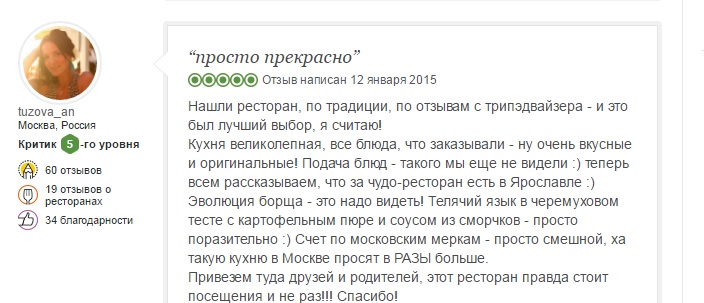 Address: Yaroslavl, Sovetskaya str., 28
Address: Yaroslavl, Sovetskaya str., 28
Phone number: +7 4852 72-13-53
Finally: Millennium Park
The Millennium Park became a gift for the thousandth anniversary of the city of Yaroslavl, the foundation date of which is 1010. It took the place of the former hippodrome on Kotoroslnaya Embankment and it truly transformed the formerly desolate territory. Besides the ordinary residents of Yaroslavl, the city administration and even honorary public figures took part in the improvement of the park: Valentina Tereshkova, Boris Gryzlov, Alexandra Pakhmutova and Nikolai Dobronravov. The park is incredibly beautiful: the view of endless Volga and the feel of ancient city history makes the walk special.

How to get there: Kotorosolnaya embankment, city center.
We've been waiting for you! The journey was long, but interesting.
Did you remember to book a spa visit and a table for dinner?
It is great pleasure to tell you of the best things to do in Ples. Our guests' favorite leisure activities are described here. People come to Ples for tranquillity and long walks the routes of which we have invented by taking all the most interesting places into account.
In the meantime, we will describe the way back.
Ples-Moscow route (via Ivanovo to Suzdal)
Distance: 132 km from Ples. 2.2-5 hours on the way.
The origin of the name of name Suzdal comes from an ancient Russian word "Suzidati", meaning "to create", which at that time also had the meaning "to mold". According to this point of view, it can be assumed that the name "Suzdal" meant something like "the clay town".
Main attractions: the Intercession Monastery, the Shchurovo Gorodishche Museum, the Wax Museum, the Museum of Wooden Architecture, the Nativity Cathedral, the Suzdal Kremlin.
Suzdal. Trivia.
- Not just Moscow, but Suzdal too was the capital - not for two or three decades, but for about two hundred! In the XIV century the town lost its independence, becoming part of the Moscow Principality.
- The town of Suzdal occupies only 15 square kilometres of area and has little more than 10 thousand people. And yet there are 53 temples in Suzdal.
- Every second Saturday in July a Cucumber Festival is held in Suzdal. This festivities are large scale: a concert of folklore groups, games, attractions, a folk crafts fair, and most importantly — tasting of all kinds of cucumber dishes.
- The 1964 film "The Marriage of Balzaminov" (directed by Konstantin Voinov), starring Georgy Vitsin, was shot in Suzdal.
- Of the industrial enterprises only a mead factory is operating, and the majority of residents work in tourism sector.
- There are no high-rise buildings in Suzdal, all buildings are no higher than 2 floors.
Restaurants:
We recommend having a snack at the café Uley ("the Beehive"). That's where you can eat your fill! the portions are simply huge, and the service is top-notch.
Address: Suzdal, Lenin str., 45
Phone number: +7 (49231) 2-33-03
Finally: horse carts and mead.
What is Suzdal without horse сarriages and mead? To ride dashing among ancient churches and temples: to really feel the Russian spirit. And you can't just ignore mead in Suzdal. Fortunately, the honey drink is sold literally on every corner! On the shopping street of Suzdal, near the Kremlin, there are lots of vendors.
There are famous felt boots, lacquer miniatures, souvenirs and treats of local residents: pickles, honey, mead. You can try a lot of strong mead while walking from one end of the row to the other. Every seller tries to prove that his mead is the best!
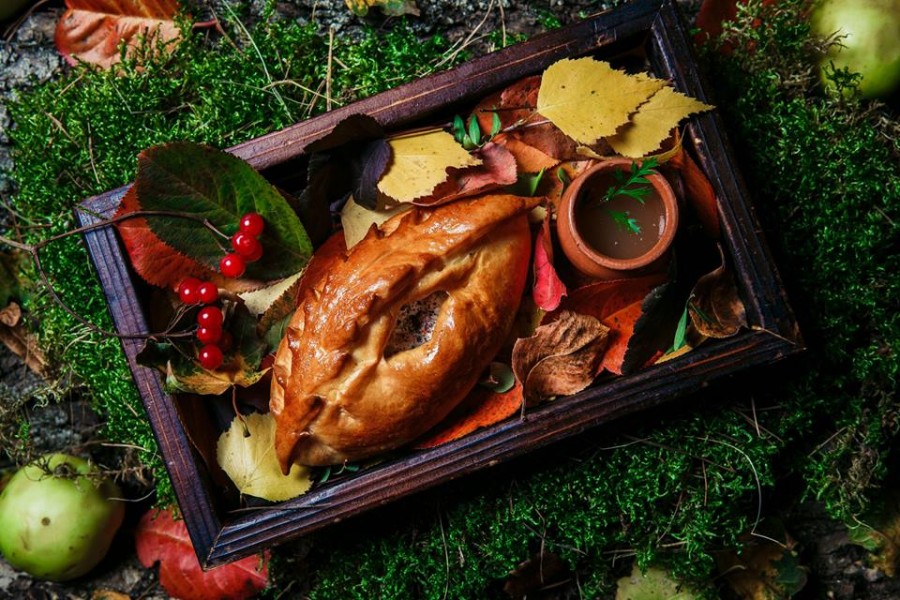
Distance: 32 km from Suzdal, 30 minutes on the way.
The city name's origin: a small fortress on the high coast of the Klyazma river was founded at the beginning of the XII century by prince Vladimir Monomakh, giving it his personal name. However, it did not took the form familiar to us yet. Originally, it was an adjective with a suffix of belonging: Volodimeri — "the city of prince Vladimir"
Main attractions: The Virgin Mary-Nativity Male Monastery, the Assumption Cathedral, the Ascension Church, the Golden Gate of Vladimir, the Gingerbread Museum, the Museum of crystal and lacquer miniatures.
Vladimir. Trivia.
- Ancient doors of the Golden Gate (made in the unique technique of "fire gilding") were removed by the Mongols in February 1238 and melted down or taken whole to the Horde. There are still many legends associated with the history of the gate. The most popular of them says that the golden doors was drowned in the Klyazma, and they may yet be found. Attempts to find the golden doors in the river were made repeatedly, even in the XX century. According to rumors, in the 1970s a Japanese company offered to clean the bottom of the Klyazma free of charge with ф condition to take everything valuable that would be found during the work.
- The Assumption Cathedral, St.Demetrius Cathedral and the Golden Gate are included in the UNESCO World Heritage List.
- Vladimir is home to the famous Vladimir Central prison. According to official statistics, there was not a single successful escape from the Vladimir Central. At the same time there is a legend that somewhen in 1970-80 two prisoners managed to climb over the barbed wired prison wall unnoticed. But, having jumped down, they found themselves not on the outside, but on the parade ground of the nearby Law Institute, which did not go unnoticed by the students and teachers. It is also often said that one of the founders of the Red Army, Mikhail Frunze, fled from the Central. The famous revolutionary did escape, yet not from the prison itself, but from the building of the Vladimir Justice Court near Cathedral Square.
Restaurants:
There are more than enough places to eat out at in Vladimir. We will tell you about one restaurant we love: the Oblomov. Located in the historical center, the Oblomov restaurant of European and Russian cuisine surprises you with its uniquely aristocratic atmosphere.
Address: Bolshaya Moskovskaya str., 19
Phone number: +7(4922) 32-68-18, +7-915-767-08-04
Finally: The Church of the Intercession on the Nerl.
The Church of the Intercession on the Nerl is distinguished by the harmony of proportions, its elegance of silhouette and complete fusion with the surrounding landscapes. In spring, the single-domed white stone temple, like a swan, rises above the waters of the Nerl oxbow lake, in winter the monument seems to grow out of snowdrifts, in summer - from the dense grass of flood meadows.
The precise year of construction of this famous church is unknown. The traditional dating of 1165 or 1165-1167 is based on a very late source — "The Life of Andrey Bogolyubsky".
How to get there: If you go from Vladimir to Bogolyubovo you need to turn behind the Bogolyubovsky Monastery - the first turn to the right after entering the village. After the Bogolyubovskaya railway station, you need to cross the tracks on foot, and walk through the meadow along a paved path that leads through the meadow to the church, for about a kilometer.


